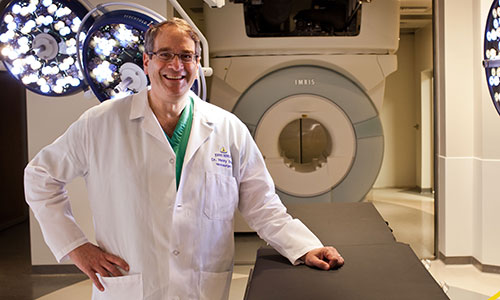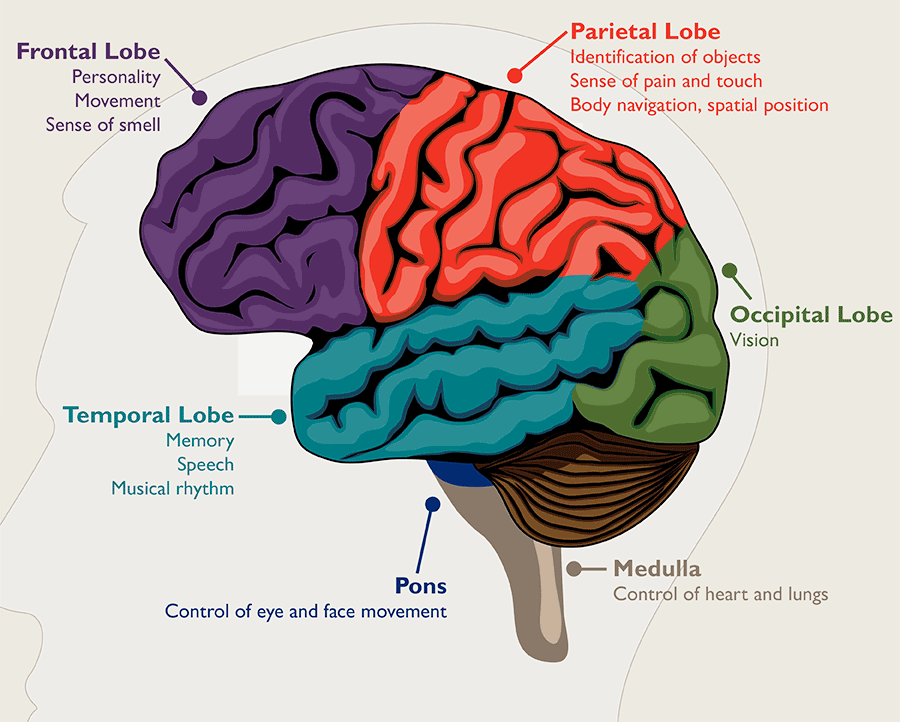What is a brain tumor?
A brain tumor is a growth of abnormal cells in the brain. The anatomy of the brain is very complex, with different parts responsible for different nervous system functions. Brain tumors can develop in any part of the brain or skull, including its protective lining, the underside of the brain (skull base), the brainstem, the sinuses and the nasal cavity, and many other areas. There are more than 120 different types of tumors that can develop in the brain, depending on what tissue they arise from.
How common are brain tumors, and are they dangerous?
In the United States, brain and nervous system tumors affect about 30 adults out of 100,000. Brain tumors are dangerous because they can put pressure on healthy parts of the brain or spread into those areas. Some brain tumors can also be cancerous or become cancerous. They can cause problems if they block the flow of fluid around the brain, which can lead to an increase in pressure inside the skull. Some types of tumors can spread through the spinal fluid to distant areas of the brain or the spine.
How is a tumor different from a brain lesion?
A brain tumor is a specific type of brain lesion. A lesion describes any area of damaged tissue. All tumors are lesions, but not all lesions are tumors. Other brain lesions can be caused by stroke, injury, encephalitis and arteriovenous malformation.
Brain Tumor vs. Brain Cancer
All brain cancers are tumors, but not all brain tumors are cancerous. Noncancerous brain tumors are called benign brain tumors.
Benign brain tumors typically grow slowly, have distinct borders and rarely spread. Benign tumors can still be dangerous. They can damage and compress parts of the brain, causing severe dysfunction. Benign brain tumors located in a vital area of the brain can be life-threatening. Very rarely, a benign tumor can become malignant. Examples of typically benign tumors include meningioma, vestibular schwannoma and pituitary adenoma.
Malignant brain tumors are cancerous. They typically grow rapidly and invade surrounding healthy brain structures. Brain cancer can be life-threatening due to the changes it causes to the vital structures of the brain. Some examples of malignant tumors that originate in or near the brain include olfactory neuroblastoma, chondrosarcoma and medulloblastoma.
Primary vs. Metastatic Brain Tumors
Primary brain tumors are tumors that start in the brain. Examples of tumors that most often originate in the brain include meningioma and glioma. Very rarely, these tumors can break away and spread to other parts of the brain and spinal cord. More commonly, tumors spread to the brain from other parts of the body.
Metastatic brain tumors, also called secondary brain tumors, are malignant tumors that originate as cancer elsewhere in the body and then metastasize (spread) to the brain. Metastatic brain tumors are about four times more common than primary brain tumors. They can grow rapidly, crowding or invading nearby brain tissue.
Common cancers that can spread to the brain are:
Brain Tumor Locations
Brain tumors can form in any part of the brain, but there are certain regions where specific tumors form:
- Meningiomas form in the meninges, the protective lining of the brain.
- Pituitary tumors develop in the pituitary gland.
- Medulloblastoma tumors arise from the cerebellum or brainstem.
- Skull base tumors grow on the underside of the brain, called the skull base.
Other brain tumors are described by the kinds of cells they are made of. For instance, gliomas are composed of glial cells.
Learn more about these and other brain tumor types.
Brain Tumors in Children
Brain tumors are the most common solid tumor in children and adolescents, affecting about 5,000 children in the U.S. each year. Several different types of brain tumors can occur in children, including astrocytomas (e.g., glioblastoma multiforme), gliomas, ependymomas and medulloblastomas.
Learn more about brain tumors in children.
Brain Tumor Symptoms
Different parts of the brain control different functions, so brain tumor symptoms will vary depending on the tumor’s location. For example, a brain tumor located in the cerebellum at the back of the head may cause trouble with movement, walking, balance and coordination. If the tumor affects the optic pathway, which is responsible for sight, vision changes may occur.
The tumor’s size and how fast it’s growing also affect which symptoms a person will experience.
In general, the most common symptoms of a brain tumor may include:
Can you have a brain tumor with no symptoms?
Brain tumors don’t always cause symptoms. In fact, the most common brain tumor in adults, meningioma, often grows so slowly that it goes unnoticed. Tumors may not start causing symptoms until they become large enough to interfere with healthy tissues inside the brain.
Brain Tumor Causes and Risk Factors
Doctors don’t know why some cells begin to form into tumor cells. It may have something to do with a person’s genes or his or her environment, or both. Some potential brain tumor causes and risk factors may include:
- Cancers that spread from other parts of the body
- Certain genetic conditions that predispose a person to overproduction of certain cells
- Exposure to some forms of radiation
Are brain tumors hereditary?
Genetics are to blame for a small number (fewer than 5%) of brain tumors. Some inherited conditions put individuals at greater risk of developing tumors, including:
- Neurofibromatosis
- Von Hippel-Lindau disease
- Li-Fraumeni syndrome
- Familial adenomatous polyposis
- Lynch syndrome
- Basal cell nevus syndrome (Gorlin syndrome)
- Tuberous sclerosis
- Cowden syndrome
Brain Tumor Diagnosis
Diagnosing a brain tumor usually involves a neurological exam, brain scans and a biopsy, if it can be done safely.
- A neurological exam may include a variety of tests to evaluate neurological functions such as balance, hearing, vision and reflexes.
- A variety of imaging techniques, including CT (or CAT) scan, MRI, occasionally an angiogram or X-rays can be used to identify the tumor, pinpoint its location and/or assess the function of your brain.
- If doctors cannot safely perform a biopsy (tissue sample collection and analysis), they will diagnose the brain tumor and plan the treatment based on other test results. If a biopsy was possible, doctors can use it to determine the tumor grade (how aggressive it is), as well as study the tumor tissue for any biomarkers that can help personalize the treatment approach.
Depending on your symptoms, doctors may also perform these tests to help confirm the diagnosis and rule out other conditions:
- Lumbar puncture to collect a sample of cerebrospinal fluid and see if it contains traces of the tumor cells.
- Evoked potentials studies to measure electrical activity in the nerves and/or electroencephalography (EEG) to measure electrical activity in the brain.
- Neurocognitive assessment to evaluate any changes in cognition and well-being.
- Neuro-ophthalmological examination to assess for signs of tumor affecting the eyes.
- Endocrinological evaluation to assess hormone function.
Proper diagnosis is essential in determining the best course of treatment.
Brain Tumor Grading
The grade of a brain tumor defines how serious it is. Using the biopsy sample, a pathologist will examine the tumor under a microscope to determine its grade. Brain tumor grading is a category system that describes the brain tumor cells and indicates how likely the tumor is to grow and spread.
Brain tumor grading uses a scale from 1 (least aggressive) to 4 (most aggressive).
(World Health Organization tumor grading system)
Grade I brain tumor
- Benign (noncancerous)
- Slow-growing
- Cells look almost normal under a microscope
- Usually associated with long-term survival
- Rare in adults
Grade II brain tumor
- Relatively slow-growing
- Sometimes spreads to nearby normal tissue and comes back (recurs)
- Cells look slightly abnormal under a microscope
- Sometimes comes back as a higher grade tumor
Grade III brain tumor
- Malignant (cancerous)
- Actively reproduces abnormal cells
- Tumor spreads into nearby normal parts of the brain
- Cells look abnormal under a microscope
- Tends to come back, often as a higher grade tumor
Grade IV brain tumor
- Malignant
- Most aggressive
- Grows fast
- Easily spreads into nearby normal parts of the brain
- Actively reproduces abnormal cells
- Cells look very abnormal under a microscope
- Tumor forms new blood vessels to maintain rapid growth
- Tumors have areas of dead cells in their center (called necrosis)
A changing diagnosis
The grade of a brain tumor might change, usually to a higher grade, often without a cause. It’s also possible that the biopsy sample might not represent the entire tumor, giving an inaccurate initial data for the grade.
A change from a low-grade tumor to a high-grade tumor happens more often in adults than in children.
Brain Tumor Staging
Staging refers to how far a tumor has spread. If a tumor has migrated to other parts of the body, it has metastasized. Staging is often done for other types of tumors but not primary brain tumors. This is because brain tumors are unlikely to spread beyond the nervous system.
Conversely, other types of tumors (e.g., lung cancer) can spread to the brain. Tumors that have spread to the brain are advanced stage.
What does the size of a brain tumor mean?
Because larger tumors are more likely to interfere with normal brain function, they more often cause symptoms and complications.
Brain Tumor Treatment
The most common treatment for brain tumors is surgery. For some tumors, surgical removal and continued monitoring may be the only treatment needed. Common surgical approaches to brain tumor removal include craniotomy, neuroendoscopy, laser ablation and laser interstitial thermal therapy.
Chemotherapy and radiation therapy can be used to treat brain cancer by helping shrink the tumor, slowing down its growth and/or preventing it from coming back. External beam radiation therapy, stereotactic radiosurgery and proton therapy are some of the radiation treatments for brain tumor.
Learn more about these and other brain tumor treatment options.
The Johns Hopkins Brain Tumor Center

The Johns Hopkins Comprehensive Brain Tumor Center is one of the largest brain tumor treatment and research centers in the world. We tailor each patient's treatment using an array of advanced approaches, including emerging treatments such as tumor-treating fields and MRI-guided laser ablation.
Brain Tumor Prognosis
Brain tumor can be a frightening diagnosis. It’s important to partner with a medical team you trust to determine the best next steps, whether it’s observation, surgery, radiation therapy or another treatment. How successful your personal outcome will be depends on many factors, including:
- The type of brain tumor, its size, grade and location
- Whether the tumor has spread within the brain or to other parts of the body
- Your age and overall health
- How long you had symptoms before you were diagnosed with a brain tumor
- How much the brain tumor affects your ability to function
- Your treatment preferences
- The expertise of your treatment team
There is no projected survival rate for those diagnosed with a brain tumor, as individual circumstances play a big role. For example, some malignant tumors can be successfully controlled by radiation therapy. Others, because of their location, may be life-threatening even if they are benign. Doctors have to look at thousands of patients with similar characteristics to see a trend in how certain tumors progress and how different treatments affect them.
Your overall outlook and prognosis are likely to change as you undergo various treatments. If you have surgery, how much of the tumor the neurosurgeon can remove will impact what will happen next. Other brain tumor treatments will determine future steps as well.





